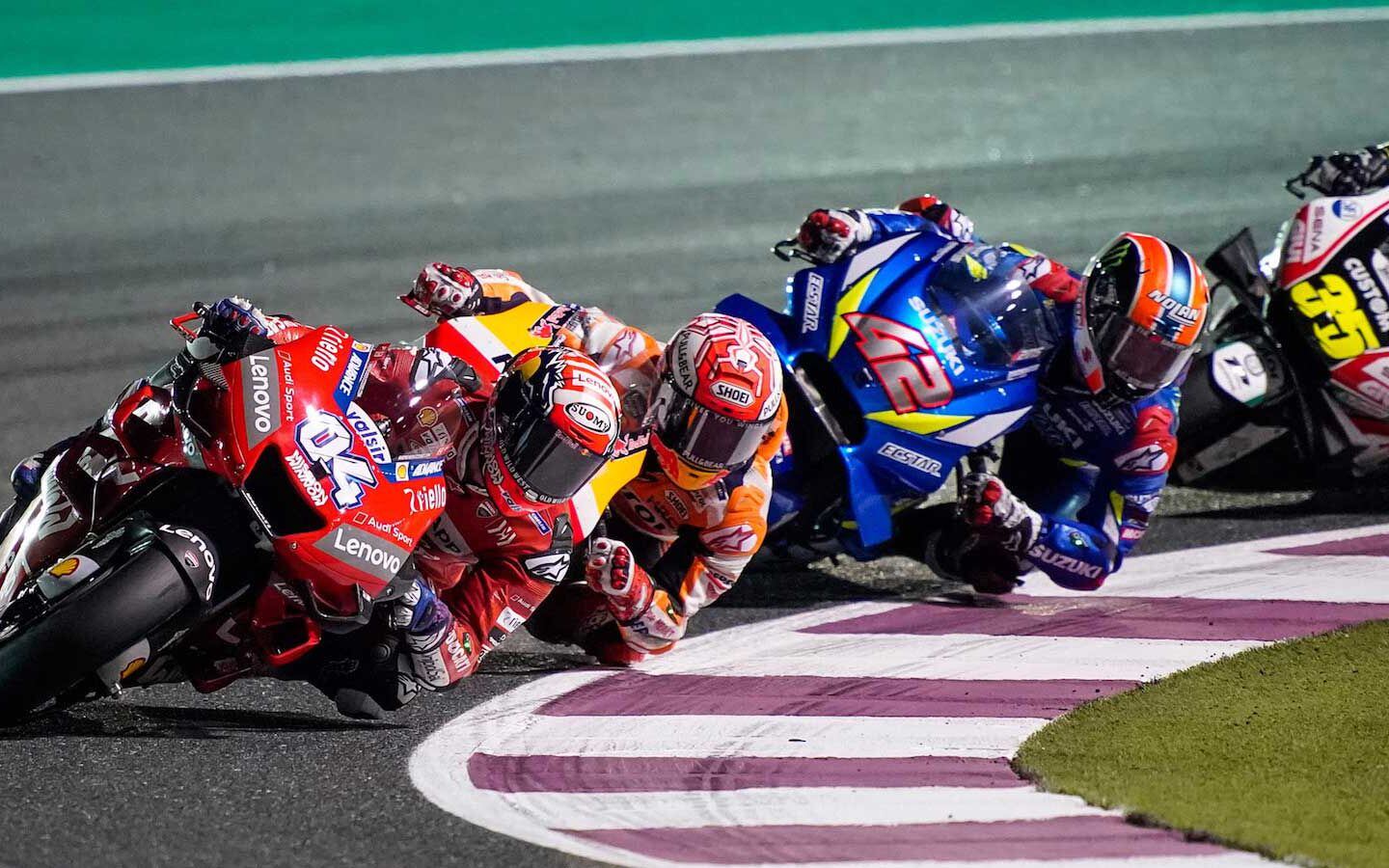One of our readers commented on my coverage of the recent MotoGP race in Qatar, saying, "Why don't they save the tires by staying in the pits, then come out and really race for five laps?" There are plenty of Formula 1 fans who feel the same. They don't want to read race reports about how the teams use fiddly technology to get the most out of their tires; they want to read about "goin' fer it."
The bottom line, as all racing enthusiasts (as opposed to “fans”) know, it that racing has always been about tires. When Ray Harroun won the first Indianapolis 500 auto race in 1911, he drove to a carefully thought-out strategy. There had been a few races on the new Indy oval track before that first 500, and Harroun studied the lap times and the distances between tire changes. He decided, based on his best estimate of how much better tires were becoming each racing season, that the 500 would be won at an average speed of 76 mph. He saw, from what had happened in earlier races, that drivers who tried to build up an early lead tended to wreck their tires, either spending more-than-average pit time or destroying their cars after losing control.
Harroun’s crew was not impressed by his plan, for when the race started, he stuck to his scheduled speed, letting others streak out front—“goin’ fer it.” One by one, the leaders pitted early and more frequently, fell back. At the end, there was Harroun’s Marmon Wasp leading at the finish. Racers race to win, because prize money and the top rides and paychecks go to the drivers and riders who win.
In 1981, 500cc Grand Prix motorcycle roadracing played out similarly. Marco Lucchinelli let the “rabbits” go in the early laps, knowing their tires would be turning to grease in 10 laps. He cruised easily downfield, maybe fifth to seventh place, waiting and conserving his tires. When the others’ rocket fuel had burned out, he had tire grip left, and moved up. One by one, he picked them off.
Kenny Roberts was riding Yamaha’s new missile, the 0W54 square four, with 150 hp to the 135 of Lucchinelli’s Suzuki. Kenny managed to win at Hockenheim, but his rear Goodyear looked like it was made of melted black cheese that had been combed into dangling strands. He also won the next race at Monza in the rain. “In the rain,” Roberts said, “The guy on the fastest machine wins because everybody has to putt through the corners at the same speed.” But patient Lucchinelli was world champion that year.
Okay, why not just make tires that can, you know, just take it? That's what happened at Daytona in 1979, the year of what the riders called "the tire of cement." Goodyear, expecting Roberts to go lots faster than its tire tester Mike Baldwin, made a very hard tire to match that expectation. As you would expect, it had little grip and went around corners at comically limited lean angles. The industry makes hard, long-lasting tires like that for taxicabs.
Asked what he thought would happen in the 200, Mick Grant said, “I think the riders will accumulate in the right-handers.” And that’s just where the crashes were.
Because Daytona is a left-hand course, the right shoulders of race tires run cooler than the left, reducing their grip even more. The result was that while riders could ride on those hard tires, they weren’t really racing, just trying to stay up on that glassy rubber (the “glass point” of rubber is a temperature below which the rubber hardens into a glass-like state. Racing rubber compounds have quite high glass points).
When there is tire competition (rather than the present system of identical “spec” tires), tire companies have to push hard to develop increased grip in hope of sharing the limelight of a big win. But as you push toward higher grip, you also elevate tire temperature and reduce tire durability. On a fast track like Daytona, there is a good chance that someone, in practice, will feel the vibration that warns that tire blistering or chunking is taking place. Barry Sheene was badly injured at Daytona in 1975 when his rear tire came apart past start-finish. No tire maker wants that kind of publicity, so the development of race tires is an approach conflict: trying to give tires the grip to win, knowing that, in general, the faster the tire, the shorter its life.
The response at Daytona was to change tires twice in the race, using equipment developed by the Japanese Big Four in the Suzuka 8 Hours endurance event. Every maker could build a faster 75-mile tire than they could a 200-mile tire.
I have seen several times what riders in the Daytona 200 do when two or more are close together after the second fuel/tire stop. Do they carve each other up, furiously outbraking one another and making hard passes in a bravura display of pure aggression? No, they do not. Instead they cruise, nose to tail, because they know their best chance of winning is to come off the chicane second, accelerate in the leader’s draft, and pull out to pass and win at the line. That rider will need all the tire possible for that last left, right, left through the chicane and out in second gear, accelerating hard. That’s why they cruise. Rubber in the bank.
And there's another reason: All experienced racers know that when two or more riders carve one another up, they slow down because honk-honk, beep-beep riding consumes rider processing power that should be focused on going fast. All too often two riders dueling one another have been caught and passed by a third rider who is more interested in winning than in pointless back and forthing.
For the moment, riders are in races to win, and they will do whatever it takes to do so. What riders talk about is tires and how to find the choices and techniques that will let them fight down to the last lap. Spectators are at the track or in front of their TVs for the excitement. Sometimes, but not always, those two goals are satisfied simultaneously. It would be hard to imagine a more exciting race than MotoGP’s season opener in Qatar: eight riders at the front in the first half, then five, with constant changes of position, and finally just Andrea Dovizioso and Marc Márquez, last lap, last turn, dead equal until Dovizioso squeaked it by 0.023 second.
It is my hope that race fans will evolve into racing enthusiasts as they learn more about what racing actually is.












/cloudfront-us-east-1.images.arcpublishing.com/octane/WVYKJFMINVFMFH37AE4OUEWVIM.jpg)

/cloudfront-us-east-1.images.arcpublishing.com/octane/JJ3MC6GNDFF5ZNYD3KD3E4EY7Y.jpg)
/cloudfront-us-east-1.images.arcpublishing.com/octane/XH2ETEU4NVGDFNQO2XT2QQS5LU.jpg)
/cloudfront-us-east-1.images.arcpublishing.com/octane/UFG652C27BDBFPK42TDAJ5CMX4.jpg)
/cloudfront-us-east-1.images.arcpublishing.com/octane/AUE3NFVRRZDSBIDVUGIYIDQNUI.jpg)
/cloudfront-us-east-1.images.arcpublishing.com/octane/LYR62CH2WNBMHJJVXVATZHOUE4.jpg)
/cloudfront-us-east-1.images.arcpublishing.com/octane/RBCTRGBQYBDK7A6XPG3HKPS7ZQ.jpg)
/cloudfront-us-east-1.images.arcpublishing.com/octane/MQXQRYMZVBCWJIRYP3HEN3SHVE.jpg)
/cloudfront-us-east-1.images.arcpublishing.com/octane/TSPODNNEWRDSVJGUCNQTDG4ADI.jpg)
/cloudfront-us-east-1.images.arcpublishing.com/octane/X5TB7BDV4BA2RPSY54ZGK27RP4.jpg)
/cloudfront-us-east-1.images.arcpublishing.com/octane/REUHOJXRDBGZ5IHBYZCCBCISPA.jpg)
/cloudfront-us-east-1.images.arcpublishing.com/octane/52LGJTCKBFEHDF7S7H4CVUIMGM.jpg)
/cloudfront-us-east-1.images.arcpublishing.com/octane/YMWAIPIPSJAOXOU3QMJMGH37OM.jpg)


/cloudfront-us-east-1.images.arcpublishing.com/octane/EJ6KZRGAYBCVXNL2PJXL37UVWQ.jpg)
/cloudfront-us-east-1.images.arcpublishing.com/octane/AAN4TI76M5H5JMUVEIGASWXBDU.jpg)
/cloudfront-us-east-1.images.arcpublishing.com/octane/P3RXD2UCPFF37CMB7CHPVKXORY.jpg)
/cloudfront-us-east-1.images.arcpublishing.com/octane/VZEG2EJI2RDFZNHLRZMU56MD3Q.jpg)
/cloudfront-us-east-1.images.arcpublishing.com/octane/GVJQO5FFOFBWNGODOBRB4FBAW4.jpg)
/cloudfront-us-east-1.images.arcpublishing.com/octane/BIVAK2SFIBDJJM25E7I5VU2FJE.jpg)
/cloudfront-us-east-1.images.arcpublishing.com/octane/CH5VX52UG5CFHOVH5A6UYEFWWA.jpg)
/cloudfront-us-east-1.images.arcpublishing.com/octane/ZVGJNGZRU5C33N7KN23BBFKSC4.jpg)